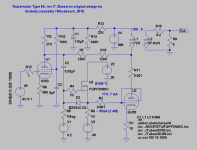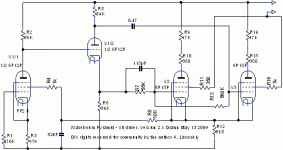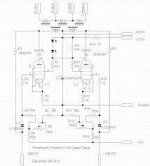If you get custom wound transformers please share the job number/manufacturer as you have piqued my interest.
Wavebourn, where are you!
Wavebourn, according to his posting years ago, worked with Edcor (in the US) to design a suitable Push-Pull transformer that he proceeded to use in his Pyramid designs. Edcor still has this transformer on their website, although it went up in price by about 55% in the last 12 months. It is good for “only” 100 watts, but sports the requisite 10k primary. See here:
https://edcorusa.com/collections/tu...0w-10k-ohms-push-pull-tube-output-transformer
I've seen Wavebourn quite reluctant to answer questions on this site during the last years, still being active promoting his amps on other channels.
Unfortunately his personal site went down last year and most of the useful data about his amps and tubes has been lost.
I've passed him some of the data I saved, but majority is lost unfortunately.
For the sake of discussion, I report here some schematics that can be still found online and that can be handy to restart the discussion.
Unfortunately his personal site went down last year and most of the useful data about his amps and tubes has been lost.
I've passed him some of the data I saved, but majority is lost unfortunately.
For the sake of discussion, I report here some schematics that can be still found online and that can be handy to restart the discussion.
Attachments
This is probably an Edcor adaptation of Anatoliy's design, because I clearly remember he said many times that he doesn't like UL designs.
Most probably the original design was without UL taps, then Edcor added them to make it more adaptable to most common designs.
I agree that in most cases UL alone is not enough and gives a clear sense of compression to the sound due to its own curves.
Certain tubes, like EL84, can benefit of small amounts of UL (that simplifies the supply of the screens) together with other kinds of local feedback, giving the possibility to have simple two stages amps with triode curves on both stages and almost pentode-like efficiency on the output section.
Certain tubes, like EL84, can benefit of small amounts of UL (that simplifies the supply of the screens) together with other kinds of local feedback, giving the possibility to have simple two stages amps with triode curves on both stages and almost pentode-like efficiency on the output section.
For sourcing the iron, German musical instrument manufacturer Dynacord may be interesting: In the late 1960ies, early 1970ies they made amplifiers capable of 80 W output power from a pair of EL 34's or 160 W from two pairs. Primary impedance of both OT's would also fit for GU50's/EL152's, and they aren't lousy either. So are the power trannies.
Best regards!
Best regards!
Wow! Historical thread resurrected! 🙂
I did not finish that project, when realized that I was plainly wrong building bush pull class AB amps. They were making sense before good class D amps were available, to get more power to drive either low efficiency speakers, or for concert halls.
For ultimate sound I found that nothing can beat properly designed SE amp.
I did not finish that project, when realized that I was plainly wrong building bush pull class AB amps. They were making sense before good class D amps were available, to get more power to drive either low efficiency speakers, or for concert halls.
For ultimate sound I found that nothing can beat properly designed SE amp.
Wavebourn,
Thanks for your return! So, you consider PP tube amps no longer worth pursuing. Fair enough.
Help us then to design and build good SE amplifiers that can use our stashes of GU50 tubes we collected to build your Pyramid design. 🙂
Thanks for your return! So, you consider PP tube amps no longer worth pursuing. Fair enough.
Help us then to design and build good SE amplifiers that can use our stashes of GU50 tubes we collected to build your Pyramid design. 🙂
Last edited:
There was one on my forum, collectively designed. It used Gu-50 in "right handed mode", i.e. all 3 grids together, driven by MOSFET follower, bias voltage AFAIR +8 volt. The driver tube was 6P15P, with feedback resistor between anodes.Wavebourn,
Thanks for your return! So, you consider PP tube amps no longer worth pursuing. Fair enough.
Help us then to design and build good SE amplifiers that can use our stashes of GU50 tubes we collected to build your Pyramid design. 🙂
Unfortunately I killed the server in my barn in California when moved to Texas. I made a coy of everything, but can't find that drive in the storage.
I will look at my old laptop, may be it is there.
Hi Wavebourne, I've been lucky to be interested in GU-50 before your server lost part of the data.
These are the curves for the right handed triode with GU-50:

These are the curves for the right handed triode with GU-50:
My server lost all data. And I donated it (HP blade) to somebody who collected metal scrap from driveways.
I have a "placeholder" in the cloud temporary, https://wavebourn.com
I have a "placeholder" in the cloud temporary, https://wavebourn.com
For the sake of discussion, I report here some schematics that can be still found online and that can be handy to restart the discussion.
and what is the third scheme?
The third scheme was just a part with output Gu-50 tubes.
Bias adjustment pots, resistors from anodes going to anodes of a pentode LTP driver, VACTROL LEDs in screen grids to sens approach to clipping.
Bias adjustment pots, resistors from anodes going to anodes of a pentode LTP driver, VACTROL LEDs in screen grids to sens approach to clipping.
- Home
- Amplifiers
- Tubes / Valves
- Pyramid-IX monoblock, 200W from 4x GU-50


